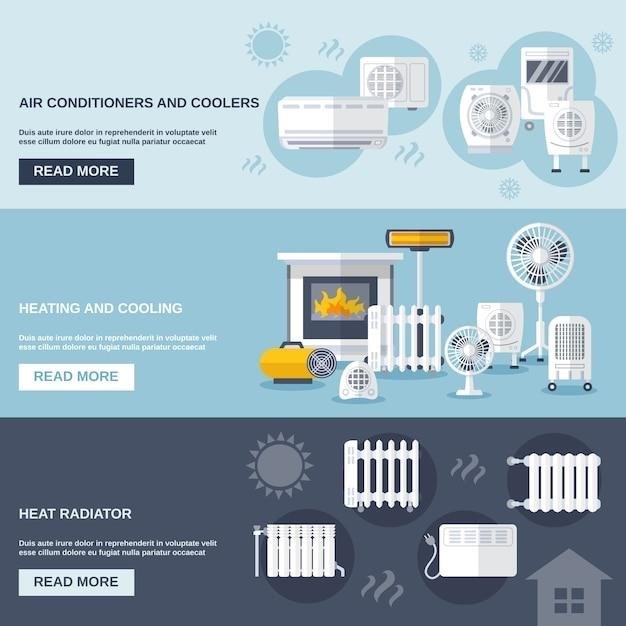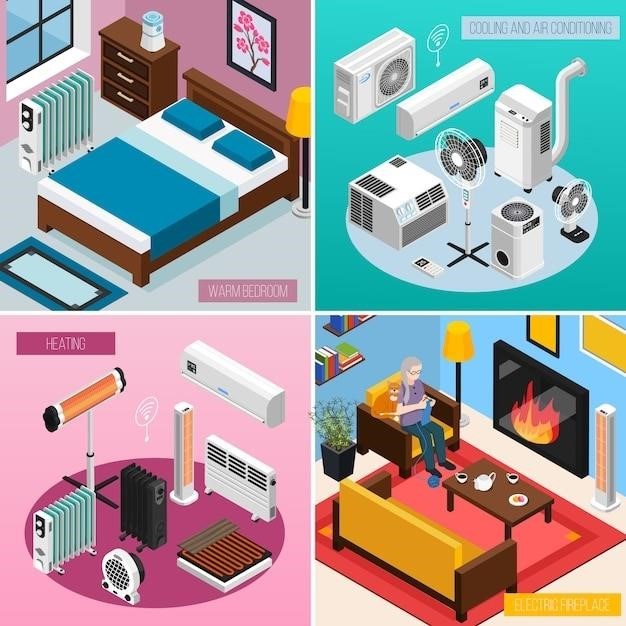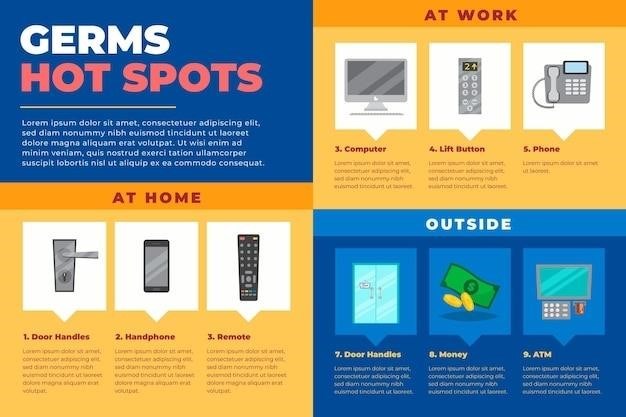NewAir Portable Air Conditioner Manual⁚ A Comprehensive Guide
This manual provides a complete guide to your NewAir portable air conditioner‚ covering safety‚ parts‚ installation‚ operation‚ maintenance‚ troubleshooting‚ and warranty information. It includes details on cooling‚ dehumidification‚ and optional heating modes‚ ensuring optimal performance and longevity. Consult this guide for any questions or concerns.
Safety Precautions and General Instructions
Before operating your NewAir portable air conditioner‚ carefully review all safety instructions in this manual and on the unit itself. Always operate the unit in an upright position on a flat‚ level surface‚ at least 14 inches away from other objects. Never place objects on top of the unit. Do not use a damaged power cord; replace immediately if damaged. Ensure proper grounding to prevent electric shock. Never attempt repairs yourself; contact qualified service personnel for any repairs or maintenance.

Keep the unit away from flammable materials and sources of ignition. Do not insert fingers or other objects into the air intake or exhaust vents. Always unplug the unit before cleaning or performing any maintenance. Children should be supervised when near the appliance. Regularly inspect the power cord and plug for any damage. Do not operate the unit if it is damaged or malfunctioning. If the unit is not working correctly‚ turn it off immediately and contact customer support.
For optimal performance and safety‚ follow all instructions outlined in this manual. Improper use can lead to damage or injury. Ensure adequate ventilation around the unit. Do not cover the air intake or exhaust vents. Refer to the troubleshooting section for assistance with common issues. Never operate the unit in an environment that is excessively humid or dusty.
Parts List and Identification
Familiarize yourself with the components of your NewAir portable air conditioner using the diagrams and descriptions provided in this manual. Key components typically include⁚ the control panel (featuring buttons and display for operation)‚ the air filter (responsible for trapping dust and debris)‚ the water tank (for collecting condensate in non-self-evaporative models)‚ and the exhaust hose (essential for venting hot air outside). Other parts may include casters for easy mobility‚ carrying handles for transport‚ and air louvers for directional airflow control.
Locate the air intake and outlet vents; these are crucial for efficient cooling and ventilation. Identify the power cord and its connection point to the unit. Examine the window kit components (if included)‚ which comprise parts necessary for secure installation in a window. Refer to the included diagrams for precise placement and function of each part. Understanding the location and purpose of each component will enhance your ability to operate and maintain your NewAir air conditioner effectively and safely. Accurate identification prevents improper use and potential damage;
Consult this section frequently for reference while assembling‚ using‚ cleaning‚ or troubleshooting your unit. If any parts appear damaged or missing‚ contact NewAir customer support immediately. Detailed illustrations are provided to assist in the identification of each component and its location on the unit. Proper identification ensures safe and efficient operation.
Installation and Setup Guide⁚ Window Kit and Placement
Proper installation of your NewAir portable air conditioner is crucial for optimal performance and efficiency. Begin by selecting a suitable window for installation; ensure it’s large enough to accommodate the exhaust hose and allows for proper ventilation. The window should also be securely sealed to prevent air leaks. Carefully examine the included window kit; components typically include adjustable panels‚ seals‚ and fasteners. Follow the step-by-step instructions provided in the manual to assemble the window kit. Ensure a snug fit to prevent unwanted air infiltration.
Securely attach the assembled window kit to your chosen window‚ ensuring a tight seal to maximize cooling efficiency. Connect the exhaust hose to the back of the air conditioner unit and then securely attach the other end of the hose to the window kit. This creates a pathway for the hot air to be expelled outside. Position the air conditioner unit near the window to minimize the hose length. Avoid placing the unit on uneven surfaces‚ or in direct sunlight‚ to prevent instability and reduce efficiency. Ensure the power cord is properly connected to a grounded outlet before turning the unit on.
After installation‚ inspect all connections to ensure a secure fit and prevent air leaks. Test the unit’s operation to verify proper ventilation. If any issues arise‚ consult the troubleshooting section of this manual or contact NewAir customer support for assistance. Correct installation is key to maximizing your air conditioner’s cooling capacity and energy efficiency. Proper venting is essential for preventing overheating and ensuring optimal performance.
Operation and Control Panel Functions
Familiarize yourself with your NewAir portable air conditioner’s control panel before operation. The control panel typically features buttons or a dial for selecting the desired operating mode (cool‚ dehumidify‚ fan‚ or heat‚ if applicable). A temperature setting adjustment is usually included‚ allowing you to customize your preferred temperature. Many models incorporate a timer function‚ enabling you to program the unit to turn on or off automatically after a specified duration. A fan speed control is commonly present‚ offering options for low‚ medium‚ or high airflow.
Some NewAir models include additional features such as a sleep mode‚ which gradually adjusts the temperature throughout the night for energy efficiency and enhanced comfort; Others may offer a swing function‚ enabling automatic oscillation of the air louvers for broader air distribution within the room. A display screen usually indicates the current settings‚ including the selected mode‚ temperature‚ fan speed‚ and timer status. Refer to the specific instructions in your user manual for detailed explanations of each button and function. The remote control‚ if included‚ mirrors the functions on the control panel‚ offering convenient operation from a distance.
Before operating the unit‚ ensure the exhaust hose is correctly connected and the water tank (if applicable) is empty or properly installed. Always unplug the unit when not in use or during maintenance. Consult the manual for any model-specific instructions or safety precautions. Proper operation ensures optimal cooling and extended unit lifespan‚ making your NewAir portable air conditioner a valuable asset in maintaining a comfortable indoor climate.
Cooling Mode⁚ Settings and Usage
To initiate cooling mode on your NewAir portable air conditioner‚ select the “Cool” or equivalent setting on the control panel or remote. Adjust the desired temperature using the temperature control buttons or dial. Lower temperatures will result in more aggressive cooling‚ but remember to set a temperature that’s comfortable and energy-efficient. The fan speed can be adjusted to your preference⁚ a higher fan speed will circulate air more rapidly‚ achieving quicker cooling but potentially increasing noise levels. A lower fan speed provides quieter operation but may take longer to cool the room.
Ensure the exhaust hose is properly vented to the outside to allow hot air to escape. Improper venting will hinder cooling efficiency and may even damage the unit. For optimal cooling performance‚ close windows and doors in the room being cooled to minimize the ingress of warm outside air. Consider using window insulation kits or weatherstripping to further improve the efficiency of your cooling efforts. Before using the air conditioner‚ inspect the air filter for any debris or blockages and clean or replace it as needed.

Regularly check the water tank (if applicable) and empty it when it becomes full. A full water tank can hinder cooling performance‚ and ignoring this could lead to malfunctions. Observe the unit for any unusual noises or smells. If you notice anything unusual‚ immediately turn off the unit and consult the troubleshooting section of your manual. If the problem persists‚ contact customer support. Remember‚ proper usage and maintenance significantly extend the lifespan and efficiency of your NewAir portable air conditioner.
Dehumidification Function⁚ How to Use Effectively
Many NewAir portable air conditioners incorporate a dehumidification function‚ designed to remove excess moisture from the air‚ improving comfort and preventing mold growth. To activate this function‚ locate the “Dehumidify” or similar setting on your unit’s control panel or remote. This mode often operates similarly to cooling mode‚ but with a slightly different operational cycle to emphasize moisture removal. The fan will continue to circulate air‚ while the compressor cycles on and off to condense and collect moisture.
The effectiveness of the dehumidification function depends on several factors‚ including the ambient humidity level‚ the size of the room‚ and the unit’s capacity. In particularly humid environments‚ you may need to run the dehumidifier for a longer period to achieve the desired level of dryness. Regularly emptying the water tank is crucial; a full tank will automatically shut down the unit preventing it from further dehumidifying. Proper ventilation is still important; even though you’re not actively cooling‚ proper air circulation aids in moisture removal.
For best results‚ close windows and doors to reduce the influx of humid outdoor air. Consider using a hygrometer to monitor the humidity levels in your room. This helps you gauge the dehumidification progress and adjust the runtime accordingly. Remember‚ excessive dehumidification can lead to dry air‚ which can be uncomfortable. Balance moisture removal with maintaining a comfortable level of humidity in your living space. Always refer to your specific NewAir model’s manual for detailed instructions and recommendations.
Heating Mode (If Applicable)⁚ Operation and Limitations
Some NewAir portable air conditioner models offer a supplemental heating function‚ typically utilizing a heat pump system. This feature recycles ambient air‚ warming it slightly before circulating it within the room; To activate heating mode‚ select the appropriate setting on the control panel or remote. The unit will draw in cool air‚ pass it over a heating element (often a resistance heating element)‚ and then expel the slightly warmer air. The exhaust hose remains necessary in heating mode to allow for proper air circulation‚ removing the cooler air from the room and allowing the warmer air to be efficiently distributed.
It’s crucial to understand the limitations of this heating function. It’s not designed to provide primary heating in extremely cold climates. Instead‚ it’s intended to offer supplemental heat‚ raising the temperature in a small room by a few degrees‚ making it more comfortable during mild‚ cool days or evenings. The heating capacity is considerably less than dedicated electric heaters‚ and the efficiency may also be lower. Expect the heating function to work best in rooms with good insulation and minimal drafts. Expect slower warming compared to a dedicated heating appliance. Always ensure the exhaust hose is properly connected and unobstructed for optimal performance.
Overuse of the heating function might lead to higher electricity bills compared to more efficient heating methods. The heating capabilities vary significantly between models‚ so always refer to your specific NewAir unit’s specifications and manual for accurate performance data and recommended usage. Never leave the unit unattended during operation and always ensure proper ventilation.
Maintenance and Cleaning⁚ Filter and Unit Care
Regular maintenance is crucial for optimal performance and longevity of your NewAir portable air conditioner. The air filter‚ located typically behind a panel on the unit‚ requires frequent cleaning. Depending on usage and environmental conditions‚ this could be as often as every two weeks or even weekly. A dirty filter restricts airflow‚ reducing cooling efficiency and potentially damaging the compressor. To clean the filter‚ gently remove it and rinse it under cool running water. Allow it to completely air dry before reinstalling. Avoid using harsh chemicals or detergents. Periodically inspect the filter for damage or significant wear and replace if necessary.
Beyond the filter‚ the unit’s exterior also requires attention. Dust accumulation on the fins and other external components hinders heat dissipation‚ reducing efficiency. Gently clean the exterior using a soft brush or vacuum cleaner with a brush attachment. Avoid using excessive water or harsh cleaners‚ as these could damage the unit’s components. Regularly check the water tank (if applicable) and empty it when full to prevent overflow and maintain optimal performance. Always unplug the unit before performing any cleaning or maintenance tasks. Refer to your specific model’s manual for detailed instructions on filter replacement and maintenance schedules.
For more thorough cleaning‚ consider using compressed air to clear dust and debris from the unit’s fins. This can improve airflow and enhance cooling performance. While most cleaning tasks can be handled at home‚ consult a qualified technician for any major repairs or service needs. Proper maintenance ensures your NewAir portable air conditioner remains efficient and provides reliable cooling for years to come. Proactive care prevents costly repairs.

